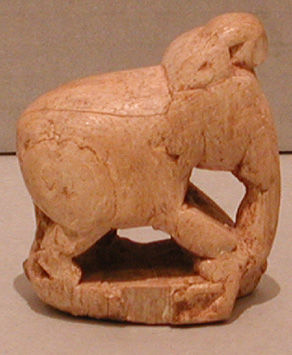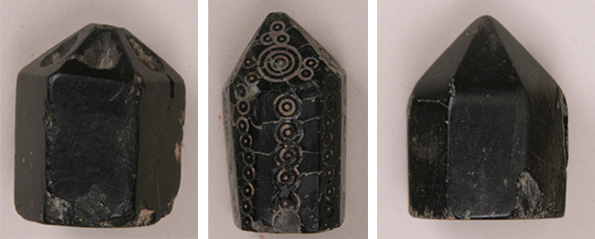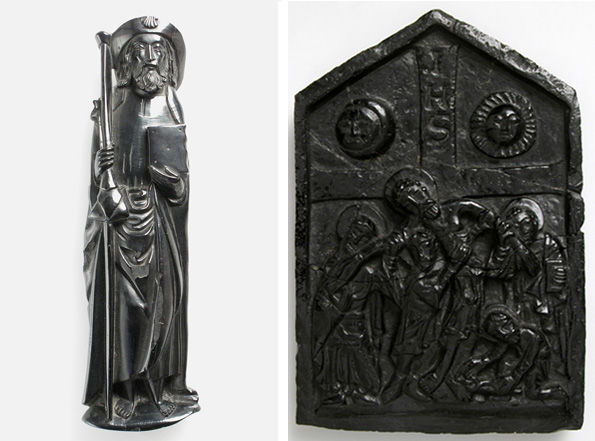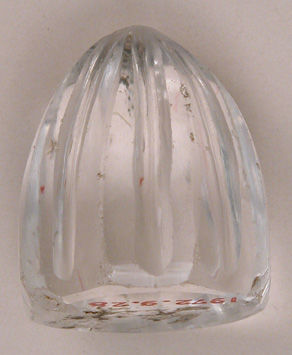For centuries, chess sets have been crafted from a wide range of materials. The Metropolitan's collection of chess pieces, numbering in the hundreds, ranges geographically from Persia to the United States, and chronologically from as early as the eighth to the twentieth century. Of these, the clear majority is of ivory, whether walrus, like the Lewis chessmen (see "The Walrus and Its Tusks"), or elephant, like our own piece in the form of an elephant. International collections reflect an almost universal, abiding preference for ivory chess pieces, from the remarkable ensemble made before the year 712 C.E. and discovered in Uzbekistan in 1977, to the "Charlemagne" chess pieces preserved in the Middle Ages at the royal abbey of Saint-Denis, to the Lapland set of about 1925 in the Met's collection (48.174.28a–p, aa–pp).
Chess piece, bishop, 7th–8th century. Western Islamic Lands. Ivory. The Metropolitan Museum of Art, New York, Pfeiffer Fund, 1964 (64.262.1)
Written sources often help fill in the incomplete historical record left by surviving pieces. For example, although the Lewis Chessmen found in the Outer Hebrides of Scotland are almost certainly Scandinavian in origin, documentary evidence tells us that ivory carvers were active on the Scottish mainland in the same period as well. Chess pieces were among the objects created by a bone carver working in Kirkcudbright, on Scotland's west coast, not far from Dumfries. The proximity of his trade to the Irish Sea (see map) suggests that his enterprise benefited from seaborne trade, as we theorize may have been the case with the Lewis Chessmen.
Among other materials used to create chess pieces, several examples seen in our collection, and others referred to in medieval sources, have piqued my interest in particular.
The Metropolitan's collection of Islamic chess pieces includes eight that are carved from jet. A hard organic material formed from decaying wood, jet is characterized by its shiny, black surface. While jet dice in the Metropolitan's collection are thought to be from Iran (48.101.256) or Egypt (1972.119.4), our jet chess pieces are attributed to Western Islamic lands.
From left to right: Chess piece, pawn. Western Islamic Lands. Jet. The Metropolitan Museum of Art, New York, Rogers Fund, 1974 (1974.98.1); Chess piece, pawn, 9th–11th century. Western Islamic Lands. Jet. The Metropolitan Museum of Art, New York, Rogers Fund, 1974 (1974.98.2); Chess piece, pawn, 9th–11th century. Western Islamic Lands. Jet. The Metropolitan Museum of Art, New York, Pfeiffer Fund, 1972 (1972.119.5)
Left: Dice, probably 8th–12th century. Iran, Nishapur. Jet; drilled and inlaid with white pigment. The Metropolitan Museum of Art, New York, Rogers Fund, 1948 (1948.101.256); Right: Dice, 10th–11th century. Egypt. Jet. The Metropolitan Museum of Art, New York, Pfeiffer Fund, 1972 (1972.119.4)
Indeed, from ancient times, jet was gathered in Asturias in Spain. In medieval Christian tradition, jet was used to carve statuettes, like the figure of Saint James, and devotional images like the relief with the Crucifixion. This tradition, established in the Middle Ages as Christian pilgrims traveled to the shrine at Santiago (Saint James) de Compostela, continues to the present day.
Left: Workshop of Santiago de Compostela (Spanish). Saint James, ca. 1410. Jet. The Metropolitan Museum of Art, New York, The Cloisters Collection, 1965 (65.67); Right: Pax, 12th century (?). Spanish. Jet. The Metropolitan Museum of Art, New York, Gift of Ella Brummer, in memory of her husband, Ernest Brummer, 1982 (1982.363.2)
Jet was also found in England and served for the making of medieval game pieces there as well. One example, found at Thelton in Norfolk, was first shown to the Society of Antiquaries of London in 1864.
Norfolk Archaeology, Volume 7. Norfolk and Norwich Archaeological Society, 1872
The black color of jet makes it a perfect material to distinguish it from opposing pieces—whether of ivory, or of amber—as in the case of a set belonging to the French king Charles V in 1380—or of rock crystal.
Islamic rock crystal chess pieces are among the earliest known in western Europe. The Metropolitan's collection contains only one example, the small size of which suggests it served as a pawn.
Chess piece, pawn, or backgammon piece, 10th–11th century or later. Western Islamic Lands. Rock-crystal. The Metropolitan Museum of Art, New York, Pfeiffer Fund, 1972 (1972.9.28)
The early history of our piece is not known, but Fatimid Egypt was renowned for the carving of rock crystal, and pieces like this were prized in Europe. In her will of 1058, the Countess Ermessind, widow of the Count of Barcelona, bequeathed her "crystal chessmen" to Saint Giles of Nîmes. Rock crystal chess pieces were sometimes incorporated into objects for use in the Church, from reliquaries to the great pulpit of Henry II in Aachen. Rock crystal remained a favored material for chess pieces and chess boards throughout the Middle Ages. Chess pieces of crystal and jasper were in the collection of Mahaut, countess of Artois (1268–1329), but were lost in the pillage of her castle at Hesdin. Edward III of England (reigned 1327–77), his mother, and his sister all possessed chess boards of crystal and jasper, the contrasting colors of the two materials providing the distinct colors for the squares.
Chess pieces, above all those of such precious materials, were subject to damage and loss. Incomplete sets were preserved and treasured as objets d’art. The inventory of Martin, king of Aragon from 1410, for example, includes some several complete sets of thirty-two pieces, but others are recorded as partial sets, including fifteen jasper chessmen and six small ivory pieces.
Chess pieces might also be carved from wood. Charles the Bold, Duke of Burgundy (reigned 1467–77) owned a set of chessmen and a table of cypress wood, then considered impervious to decay. A more exotic reference cited in Murray's History of Chess is to a set that belonged to Hugh le Despenser in 1397. It had pieces made of ginger root that were set in opposition to pieces made of "noitz muge," Old French for noix de muscade, or nutmeg. Such pieces, held in the hand, would have given off a delicate sweet scent, adding to the pleasure of the game.
Finally, there were edible medieval chessmen! At a feast in Munich in 1476, the eighth (and final?) course consisted of "a chessboard of 'almond milk' (marzipan, I presume), brown and white; the rooks and all pieces were of sugar." At Hampton Court in 1528, a dinner honoring the French ambassador featured a dessert shaped like a chessboard. In the months preceding the opening of The Game of Kings at The Cloisters, I made a habit of bringing in shortbread cookies shaped like Chessman. Little did I know that, even in this, I was following a great medieval tradition.
For further reading, I refer you again to H. J. R. Murray, A History of Chess, Oxford, 1913.




